Our guide and driver for the 10 days of our stay in Georgia was Mr. Davit Gigauri, a wonderful person who made lively conversation and fed us constantly during the day and proposed toasts late into the evenings. For his company in Georgia give Mr. Gigauri a call at +995 599434285.
Tbilisi
The capital of Georgia is a charming city which as per legends was founded when king Vakhtang Gorgasali stumbled upon hot springs when he was out hunting in 5th century AD, giving the city its name meaning 'warm'. What the king had come across was the sulphuric hot springs in the Abanotubani, 'old town' area of Tbilisi where the underground, doom shaped sulphur baths are located along the path of the sulphur rich waters flowing from the craggy mountain and joining the Mtkvari river. If the strong smell of the sulphuric water doesn't put you off, you could go for a massage and/or a bath in one of the 5 baths.
 |
| Sulphur baths at Abanotubani, old town area of Tbilisi |
The 17th century AD Narikela fortress at the top of the mountain (reached easily by a cable car ride), a beautiful blue tiled mosque along the sulphur baths, restaurants and shops selling souvenirs is the picture one can see from the heights of the 13th century AD Metekhi church with a statue of the founding king of Tbilisi astride his horse and keeping a watch over the 'old town' district.
 |
| Metekhi church and statue of Founder King of Tbilisi, Tbilisi |
 |
| Night lit Narikela Fortress, Tbilisi |
The 1500 KM long Mtkvari river flowing through the city and the strategic location of the city had many foreign rulers making a beeline for the city over the centuries. The present day Mtkvari river has a 1000+ LED lit bridge called the 'Bridge of Peace' connecting the 'old town' to the newer part of the city and the bridge is just one of the many 'contemporary' structures in the city which sit comfortably alongside numerous churches of varied architecture, style and faith representing a complex history. I personally prefer the older buildings but perhaps the 'history' of the newer buildings will be of as much interest in the future as the history of the older buildings are today.
The skyline of Tbilisi has, among others, a lit TV tower, the Narikela fortress and a statue of 'Mother of Georgia' with a bowl of wine in one hand for friends and a sword in another hand for enemies. There are numerous Museums to visit during the day and performances to choose from for the evenings. If neither of it interests you, spend the day strolling through the botanical garden at the foothills of Narikela fortress or the turtle lake on the outskirts and end the day at the 'dancing' fountain beside the 'Bridge of Peace.'
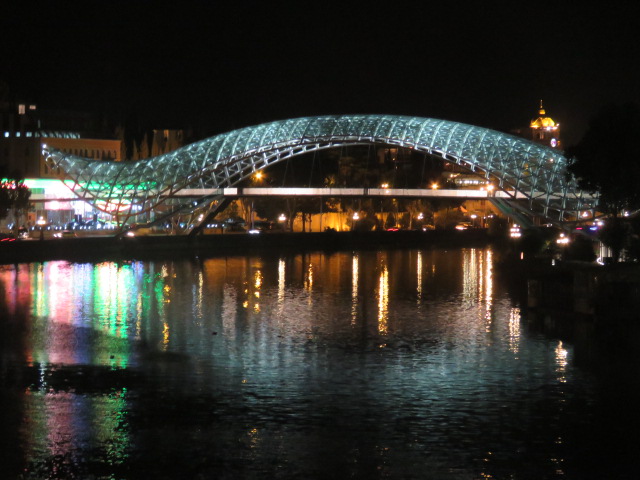 |
| Bridge of Peace, Tbilisi |
The other 'Not to be missed' are Tbilisi's very own Leaning tower at the Gabriadze puppet theatre. Do go around the city covering the Rustaveli Avenue with its impressive buildings right out of an 18th century English novel. The Opera and Ballet theatre, Rustaveli theatre, Rustaveli cinema, Parliament, a couple of museums and city hall are just a few of the prominent buildings on the road. Another road with closely packed buildings on either side of the road and all painted in lovely soft hues is the Agmashenebeli Avenue. Apparently, this is the favourite haunt for the locals to shop.
While looking at the beautiful churches and buildings which seem like they belong to a different era, don't forget to keep an eye out for buildings that look like they belong in the future. The LED lights lit 'bridge of peace' is one, Justice house is another, a little way off the bridge is a flower petal shaped public service hall, a tunnel shaped concert hall and these are just the prominent ones.
 |
| Cable car point, concert hall and Public service hall, Tbilisi |
Jvari Monastery:
Going north, away from the capital towards the Georgian Military highway, invariably the first stop is the Jvari Monastery, built of stone in 6th century AD. It stands atop a craggy mountain overlooking the charming town of Mtskheta with its beautiful Svetitskhoveli cathedral and river Aragavi who joins the 1500 KM long river Mtkvari who originates in Turkey, continues her journey through Tbilisi and to Azerbaijan and then drains into the Caspian sea.
The history of this monastery is linked to the history of Christianity in Georgia itself. In 4th century AD, St Nino, a female evangelist erected a huge wooden cross here at what was then a pagan temple. St Nino was the one who brought Christianity to the country. The architecture of the monastery is important as well as it influenced the architecture of many churches in the region,
 |
| Jvari Monastry |
 |
| View of Mtskheta town and confluence of rivers Aragavi and Mtkvari from Jvari Monastery |
Light permeates inside the monastery through a few long glass windows, the walls are adored with a few paintings of Gods and a huge cross stands at the centre under the doom shaped roof. There was a compound built around the monastery at some point but now it lies in ruins because of the exposure to elements.
Mtskheta
Having seen the distant view of the lovely Svetitskhoveli cathedral from Jvari monastery, next stop at the cathedral in Mtskheta gives a true picture of its magnitude. The history of the church dates back 1st century AD when a Jew from the town brought back Jesus' robe from Jerusalem after the crucifixion. The robe was then buried here. St Nino chose this site and directed the building of the church in the 4th century AD. The church has lived through desecration and damage by forces both of invading humans and of nature(earthquakes).
The church is a huge stone building and if one is not sufficiently awed by the proportions of it before entering it, the huge painting of Jesus on the wall facing the entrance is sure to impress anyone. This was painted by a Russian artist in the 19th century. Most of the paintings here are copies and the originals are in museums. Kings were not only crowned here, they have also been buried here. Most of the graves are at ground level and marked. I watched my step so as not to walk over any grave. What a lesson for the living, one might have been a king but now resting in the grave in the cathedral he is just a step away from being trod on by a commoner.
The cathedral is fortified and all along the inner wall of the compound, there are stalls selling handmade woolen shawls, dolls, paintings and best of all, Churchkhela, nuts stringed together and dipped in thickened grape juice.
 |
| Svetitskhoveli Cathedral in Mtskheta as seen from Jvari Monastery |
 |
| Interior of the Svetitskhoveli Cathedral, Mtskheta |
 |
| Shops within the precinct of Svetitskhoveli Cathedral. Churchkhela laid out on the table and woolen stoles, handmade dolls and carpet by the wall. |
The Georgian Military highway
The road between Tbilisi and Vladikavkaz in Russia running through the Caucasus mountain range has been the route used by invaders and traders through the ages. The drive on the road is along picturesque mountains, quaint little villages, including the popular ski resort town of Gadauri. The road reaches its highest point at Jvari Pass at a 7,815 feet ASL.
The road in its present form was built by the Russian military in 1799 after the signing of a treaty in 1783 whereby in exchange for a say in conduct of Eastern Georgian kingdom of Kartli-Kakheti, the Russians guaranteed the kingdom's territorial integrity, enabling the kingdom to put an end to all dependencies on Persia. The kingdom thought it had secured protection from invaders from the south but when Persia's new ruler Agha Md Khan attacked Tbilisi in 1795, no help came from Russia and Tbilisi and Georgia were ravaged. For more on this, look up 'Treaty of Georgievsk.'
 |
| Truck lined road to Kazbegi and the Russian border. |
After Georgian empire was annexed to Russian empire in 1801, the road was resurfaced and improved and by 1863 the bills had run to be 4 Million pounds!
Today, the road close to the border is lined with lorries and trailers as the drivers await clearance at the checkpoint.
Ananuri Fortress (70 KMs from Tbilisi)
On the Georgian Military highway lies Ananuri fortress, very close to the Aragvi river. For a small castle, it has quite a history. Occupied since 13th century by a feudal dynasty, has seen many battles, attacks by rivals, massacres, and finally revolts and uprising by local farmers in the 18th century. There are castles, 2 churches, watch towers inside the compound walls, but to me, the Zhinvali reservoir at the back of the fortress held more charm. The colour of water, a deep shade of blue is mesmerising. There is an access path from the fortress to the waters where people swim and relax on the bank.
 |
| Zhinvali Reservoir from Ananuri fortress, Georgian Military Highway |
Arch of Russian-Georgian friendship
Very close to the Jvari Pass there is an arch built to commemorate the Georgian and Russian friendship in the 200th year of the above mentioned treaty. The arch overlooks lovely high rise mountains and a deep valley with an oval shaped pond. No matter which part of the year, steeped in snow or green all around, makes a beautiful view.
Very close to the Arch are mineral springs, where water flows down mineral rich mountain and is collected by locals as having medicinal properties. The water tastes like a carbonated drink gone bad, and probably is an acquired taste.
There were huge flocks of sheep grazing on the mountain sides and from afar looked like bald patches on the green mountains. At almost all the turns, there are roads that are canopied for use in the winters when the mountains are snowed out.
 |
| Arch of Russian Georgian friendship, near Jvari pass, Georgian Military Highway. Queen Tamar in the centre of the arch. |
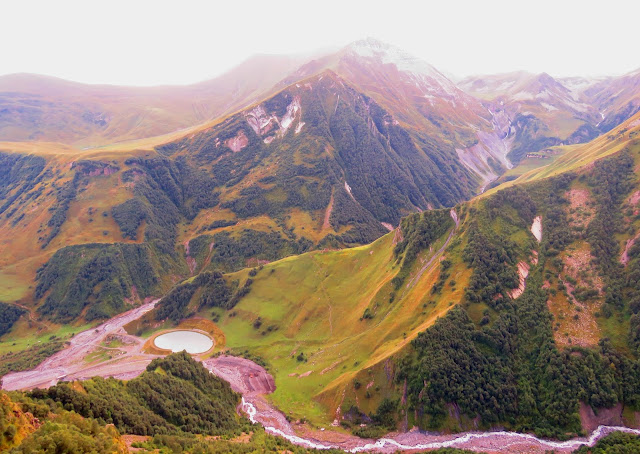 |
| View from Arch of Russian-Georgian friendship, Georgian Military Highway |
 |
| Mineral rich water flowing down the mountain near Jvari Pass and canopied roads on left for use in winter. |
Kazbegi (Stempantsminda) (157 KMs from Tbilisi)
Kazbegi is a quaint little town just a short 10 KM drive to the Russian border, located at 5,700 feet ASL with about 2,000 inhabitants, surrounded by high rise mountains, the prominent one being Mt Kazbeg, a 16,500 footer and a dormant volcano. As per legends Prometheus who stole fire from Gods and gave it to humans is tied to this mountain as punishment.
Kazbegi has a couple of museums, one of which was the house of Alexander Kazbegi, who was a 19th century Georgian writer whose famous 'Robin Hood' character Koba, from his novel, 'The Patricide', influenced Stalin. There is a statue of Alexander in the main parking area and is just next to hotel, Stepantsminda, the 'star' hotel of the village. From here one can trek up to Gergeti Trinity church, go paragliding or even climb up all the way to Mt Kazbeg. But once the sun goes down and the temperature drops, a hot meal in a cafe with soulful Georgian music is the best way to end the day or perhaps is the only way to end the day.
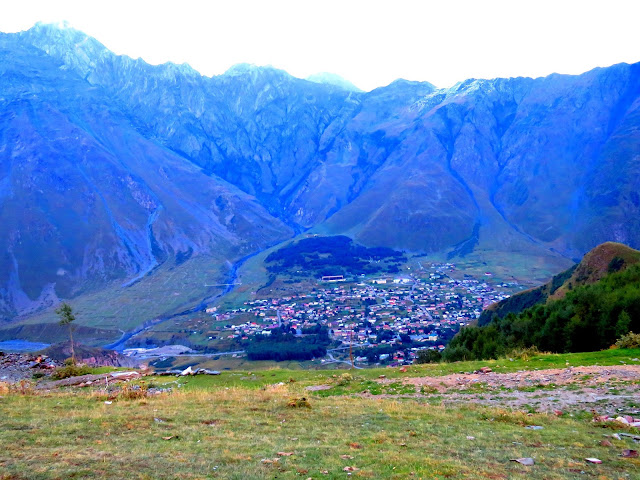 |
| View of Kazbegi from Gergeti Trinity Church |
The most popular tourist place here is Gergeti Trinity church, located in absolute isolation at a height of 7,120 feet ASL is a 14th century AD church rendered even more beautiful by the lovely view all around the church. The snow clad peak of Mt Kazbeg peeps above the closer mountain range, keeping a benevolent watch on the church. It takes a good 2-3 hour trek to get here from Kazbegi or the easier alternate is to hire a 4 wheel drive for the 20 minute drive. The church is on small hillock, there is a lovely watering hole at the foot of the hillock which provides fresh water for the trekkers who camp here. The view of Kazbegi from here is beautiful.
 |
| Gergeti Trinity church, Kazbegi |
 |
| Water fountain at the base of the hill on which the church is built |
Gori (76 KMs from Tbilisi)
North of Tbilisi, the Georgian Military highway turns west at Mtskheta to form the principal road that connects the east of the country to the west. Gori lies on this road, being as it is very close to the separatist territory of South Ossetia, the road is teasingly close to the border controlled by Russian forces. Gori was occupied by Russian troops in the 2008 Russian-Georgian war(there are buildings around the city which still bear bullet holes, a grim reminder of the horrors of a very near past), but Gori's claim to fame is her favourite son, Stalin.
It is a historical city as well, having been inhabited from at least 3,000 BC. There is a fortress built on a hill in the town and has been in existence since at least 1st century BC as per archaeological evidence. The fortress like the town has changed hands many times due to its strategic location. Much of the fort was damaged in the 1920 earthquake. But even today the fort affords a beautiful view from the town of Gori with a statute of astride King Vakhtang Gorgasali holding a sword in front of him leading the view with the fort in the background.
 |
| Fort atop hill and statue of King Vakhtang Gorgasali, Gori |
There are beautiful churches (the interior of the Virgin Mary cathedral on Niko Lomouri street is beautiful, it was built around 1810, was badly damaged in the 1920 earthquake and redone in the last couple of decades), modern looking buildings (the metallic shelled municipality building looked like a huge flower bud to me), couple of museums including the Stalin museum, beautiful town hall which until recently had a statue of Stalin in front of it (removed in the mid of the night in 2010 as part of the 'de-sovietisation' process), a quarter of a city where the entire ambiance is a recreation of the olden times, on the outskirts of the city there are grape vine growing as a canopy in front of every house and obviously each household with a secret brew of its own. But what really made an impression on me in Gori is a concept, if indeed it was meant to be one. Opposite to the Virgin Mary cathedral in a park are statues of 8 people dressed in armour and headgear seated on stones in a circle. Every statue bears signs of injury - missing hands, legs, limbs, head, deep rips in the armour and head injuries. This is the memorial to Georgian warriors, there are different versions to who exactly they are - according to one version they are brothers who were killed in WWII, another version says they died in the 2008 war with Russia, whatever may be the case, the statue is a mirror that reflects the poignant present times where nations and regions are embroiled in conflicts but the ultimate sufferer is the individual whose family, home and livelihood is destroyed, the life he so lovingly built, gone and he helplessly sits awaiting his fate, It was very touching.
 |
| Memorial to Georgian warriors, Gori |
Uplistsikhe (14 KMs from Gori)
A little way off the town of Gori is a 3,000 year old town cut into the rocky mountain. The well planned settlement is complete with dwellings, chamber for the queen, doctor's dwelling, wine pressing chambers, temples, water storage pits, pathway for excess water.... Especially impressive is the long staircase to the town from the base of the mountain via a tunnel carved in rock. The town is purely functional without any effort wasted on adoration but the view from every dwelling is the lovely Mtkvari river as she meanders her way through from Gori to Mtskheta. A Stone and brick basilica was built in 9th century AD at the summit of the town. This was an important town till the advent of Christianity to the region in 4th century AD and shifting of focus to Mtskheta.
 |
| Uplistsikhe |
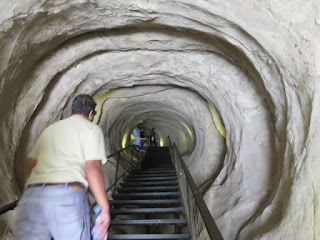 |
| Stairway at Uplistsikhe |
 |
| View from Uplistsikhe |
Shorapani (110 KMs from Gori and 42 KMs short of Kutaisi)
I wouldn't even have known the name of this little village on the highway between Gori and Kutaisi if not for the lingering memory of the fragrance of the bread that almost the whole town bakes and sells on the roadside. Nazuki is a raisin filled spiced bread freshly baked in a clay oven much like a tandoor. Tiny shops line on either side of the road, all of them baking Nazuki and selling it for as less as GEL 1 per piece and the whole town smelled like a fairyland. Had I not been asleep when Davit stopped at a shop to buy Nazuki for us, I would have taken a photo of the breads arranged on a vertical panel just by the road and had I not been too busy eating the bread and enjoying the fragrance thereafter, I would definitely have taken a few photographs. No matter how I put it, doesn't change the fact that I don't have photos but just the overwhelming memory of the fragrance that makes my mouth water 3 months hence.
This region has another claim to fame, it's the centre of the pottery industry, some very fine quality pottery. We stopped on the way back at pottery shops closer to Zugdidi which sold a wide variety of stuff from huge models of animals to painted vases. We bought painted clay mugs with designs of scenery on them but the best pottery I have ever seen was closer to the 'Nazuki' village. Coffee cups, water jugs, decorative fruits baskets, plates, wine glasses in the shape of horns, cooking pots and a variety of other things. Almost all of them unpainted. I had a hard time moving away without buying anything as I had already bought my quota of delicate items to be carried in hand baggage.
 |
| Pottery from Western Georgia |
Kutaisi is the second largest city in Georgia after the capital. Although we spent a night there we skipped all the places in and around the city in favour of 3 places which should be on any Georgian tourist's 'Not to be missed' list.
 |
| Tree lined roads from Kutaisi to Prometheus Cave |
Prometheus Cave
20 KMs from Kutaisi through tall tree lined roads is the Prometheus cave which was unearthed in 1984. The limestone caves formed in the cretaceous period (just after the Jurassic period), situated 100 metres ASL spans an area of about 16 KMs but as of now about 1060 metres of the cave divided into 16 halls with stalagmites, stalactites is open for public viewing. A walk down a stair case brings one to the entrance of the caves and the change of temperature is apparent immediately. All year round the temperature is well below 20 degree Celsius, so plan to take something to keep you warm inside. The cave has a living ecosystem, there are living creatures like bats, insects and plant life and the stalagmites and stalactites continue to form as it has for the last 100 million years. The formations are lit by lights which change colour and thus produce stunning photographs but I am not sure if it is the right thing to do. Read the link for more: https://www.occrp.org/en/investigations/2318-georgia-a-deal-done-in-the-dark.
Like any other limestone cave it's upto one's imagination to see creatures and other objects in them. The exit from the caves is via a 280 metre underground Siphon lake from which river Kumi originates. It cannot fail to remind anyone who's read the Harry Potter series of the inferi infested lake in the cave by the sea side where one of the horcruxes was hidden by Tom Riddle. Come to think of it now, I am just glad the underground lake wasn't the entrance to the caves else I would have looked for inferies in water and for Voldy at every turn and cranny.
Why the name Prometheus......He is believed to be chained in the caves for the same reason he is chained to Mt Kazbeg.
The caves are closed on Mondays. Timing: November to April - 10 am to 5 pm, May to August - 10 am to 6 pm, September and October - 10 am to 5:30 pm. Entrance fees is 7 GEL per person and the boat ride is another 7 GEL.

 |
| Limestone stalagmites and stalactites in Prometheus cave |
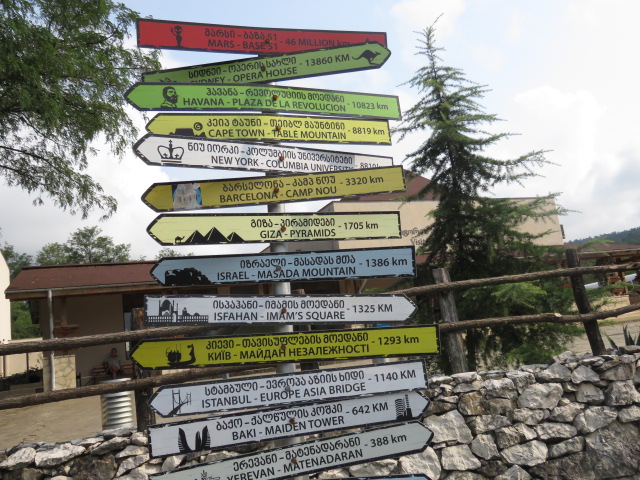 |
| Prometheus cave entrance - way to Mars at the top |
Okatse Canyon
42 KMs from Kutaisi is a natural canyon with river Gordi flowing in between the canyon. The canyon is about 10 feet at its narrowest and almost 65 feet at its widest. The depth of the canyon at its highest is almost 325 feet.
The gorge faces on either side of the river is covered in vegetation and the colour and hue of the vegetation would be different for different seasons. But whichever season one visits this place in, walking the 2 KM metal walkway and looking down the 2 hanging paths and getting a panoramic view of the nature all around would be quite an experience. When we visited in September, the vegetation was varied hues of green with hints of yellow and brown. The river, just a thin stream, hardly made a rustle while she ran her course. The ravens circling above and the distant mountains all add to the magic of the place. It looked lovely and I instantly fell in love with the place.
There are apparently detours that one can take to explore the beautiful mountains, there is a very beautiful visitors' centre built in the village where the various options can be found out and one can also look at the model of the canyon complete with the walkway. One can also visit the 200 feet Oskhapo water falls. One would have to hire a 4*4 from the visitors centre to the starting point of the walkway to the canyon and the waterfalls. There is a ticket of GEL 4 per person to enter the canyon.
This is a relatively new tourist attraction with the walkways built in 2013 at a considerable cost which makes the mountains accessible to even those who are not inclined to roughing it out. We visited the canyon on a weekday and there was hardly anyone else through the entire walk and just another family at the hanging path, it is absolutely untouched and gorgeous. The only challenge would be to capture the beauty of the canyon in photos.
 |
| Okatse Canyon |
 |
| View from the walkway of Okatse Canyon |
 |
| Model of Okatse Canyon at the visitors' centre |
Martvili Canyon
45 KMs from Kutaisi is Martvili canyon, a gorge that river Abasha has carved over time. The colour of the water is a sparkling turquoise blue.One can take a boat ride on the water. Depending on the season and the depth of the river one might have to get off the boat and walk over the exposed stone bottom while the boatman pulls his PVC boats to the water on the other side to continue the journey. This place is quite popular among locals and tourists alike and gets very crowded even on weekdays, But once in the boat you can begin to enjoy tranquility again and if there are far too many boats together to afford tranquility, concentrate on the water, the mesmerising colour will soothe you for sure. The gorge is not as as deep as Okatse and gives one a fairly good idea of how the river is shaping the rocky sides that hold her in.The boat ride costs about GEL 5 per person.
Prometheus caves (minimum of 1 hour), Okatse (2 hours) and Martvili canyons (1 hour) can all be seen in one day quite comfortably.
 |
| River Abasha and the gorge at Martvili Canyom |
Mestia (460 KMs from Tbilisi)
On the northwestern side of the country, close to the Russian border nestled in the Caucasus mountain range is the lovely town of Mestia, located at a height just 79 feet short of 5000 feet. Mt Shkhara (17,040 feet ASL), the highest peak in the country is located about 46 KMs away and in the foot of this mountain lies Ushguli which at 90 feet shy of 8,000 feet is the highest inhabited place in the European continent. The 130 KM drive from Zugdidi to Mestia is via a winding road with lush greenery tracing the Enguri river's course with some traces of habitation along the way. As one gets closer to Mestia the peaks of mountains with their snow clad summit start putting in appearances and so does the legendary Svan towers.
Over the centuries while other parts of Georgia was raided by external armies, the isolation kept the Svans protected until the Russian invasion in mid 19th century. They have also acted as safe-keepers of valuables from other parts of the country. This isolation has sculpted the tradition and culture of the Svans. I found this beautiful article while researching Mestia. http://ngm.nationalgeographic.com/2014/10/svanetia/larmer-text
Mestia is home to the Svans who are an ethnic subgroup of Georgians and are culturally and linguistically distinct. Known for their quick temper and the tradition' of 'blood revenge', which today for most part is part of folklore and dinner time gossip for rest of the Georgians with the 70 feet high Svan towers that dot the region providing evidence of the tradition. The Svan towers are mini forts. A stone house with a tall tower that could be barricaded from within from not just the elements but from the feuding party as well. There are 66 such towers in Mestia today and a total of 175 in the region.
 |
| Svan tower lined town of Mestia |
Svans are just as much known for their hospitality as their quick temper, every meal in the guesthouse was a festival spread. On the way up the highlands we stopped for coffee at a shop selling liquor, while my husband and Davit were served coffee made in their kitchen, I was served with chocolates and home brewed vodka with honey for having 'failed' to order coffee. In the guesthouse, my neighbour and her daughter offered me cheese with white wine. Davit's mother was disappointed that we couldn't take her red wine home and instead had to be content seeing us take her pickled cherries and figs but that wasn't before she served me red wine and Davit's father raised a toast of home made champagne. Whether I did drink all that alcohol and if I did, how I managed to drink it is probably a subject of another post.
Mestia is the point where mountaineers meet up to climb the mountains of Caucasus while the lesser mortals content themselves by climbing up a Svan tower. One can make a day trip to Ushguli during the summer months when the road is not snowed out(we were unable to make this journey but my research of the place doesn't let me brand it as 'sour grapes'(surely not in the land of wine)), or trek to the foothills of Mt Ushba, which can be seen from the town on a clear day or visit the Chalaadi glacier which is about 10 KMs away. A trip to Khatsvili(or Hatsvili), a ski resort town about 8 KMs away and a ride up the 2.4 KM cable car up the slopes is definitely a must do. If the weather is clear, on reaching the top Mt Ushba waves at you from the other side. The view from the top in clear weather is picture-card surreal. The ride up and down the slope with pine trees all around, view of the distant mountains and the airport's air strip, cows grazing below with nary a thought to the cable cars above and above all, the reign of silence - it's a lovely experience altogether. A cup of coffee from the restaurant at the top enjoyed at a table in the warmth of sun with the crispy air nipping at you and serene calm all around. Life truly doesn't get better than that.
 |
| Slopes of Hatsvili, Mt Ushba, the river and airstrip |
Back in Mestia, there is a Ethnographic Museum in a very pretty looking building, there are other architecture gems around the town, one of them being the glass police station, much like in rest of the country(other than the police station in Batumi, every police station we saw around the country was housed in glass buildings) There is also a funny looking statue of Queen Tamar in the town square which the Svans are not pleased with. I wonder what Queen Tamar would have thought of it if she were alive. Like the statue of Stalin in front of the town hall in Gori was brought down in the mid of night, this statue was apparently installed in the dead of the night for much the same reason. The way the cross is depicted on the statue seems to be the reason why the Svans are upset but I fail to understand why a statue should be put in a town when the people of the town don't like it.
Having finished with the short list of 'can do's' one can just breath, relax and recharge their soul. Off the main road, even the 'city' of the region is a village with neat farms with grazing cattle, men collecting grass to stock up for winter, smoke rising from the chimneys as women cook food. There isn't much to do in Mestia apart from walk around during the day and raise toasts to everything from love to world peace late into the night.
Mestia is yet to become a commercial tourist place, but that might change soon enough, there is a lot of construction activity going on in Mestia and beyond. I hope the cost of reaching this isolated place is going to ensure only the ones who truly appreciate the beauty of this place make it to the region.
 |
| Statue of Queen Tamar in the town square, Mestia |
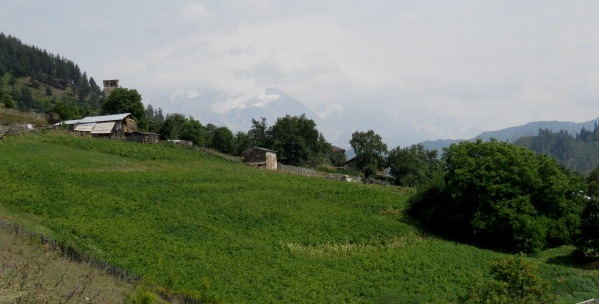 |
| A Svan farm a little way off Mestia |
 |
| A Svan villager getting her bulls to drag a log |
Batumi (134 KMs from Zugdidi)
A 263 KM drive from Mestia through mountain territory till almost Zugdidi and then onto the sea port and naval base of Poti, from thereon the black sea coast keeps company till Batumi. There is a lot of water systems near Poti - the 320 KM long river Rioni, river Kaparcha flowing parallel to the coast line for the length of lake Paliastomi, river Maltakva, lake Paliastomi (which is part of the Kolkethi national park), lake Nabadi, lake Okros and a few other smaller ones littered throughout the region making it a haven for migratory birds.
The port city of Batumi on the black sea coast is just a 20 minute drive to the Turkish border and is an ancient city that has of late transformed itself into a slick tourist centre. Just like Tbilisi, there are renovated 19th century buildings which share space with ultra modern buildings like the 130 metre high Alphabetic tower with the 33 Georgian alphabets on it, the Sherton hotel and the Batumi tower with a Ferris wheel on it, the glass McDonald's restaurant, the list goes on and if the sights of the modern stops enthralling you, just stroll over to the beautiful pebble beach that stretches almost from the airport to the seaport. The seafront promenade is apparently the longest promenade in Europe, there is a bicycle lane behind the promenade, sculptures and novelties in the park and pebble shaped resting 'chairs' for when one is tired after all the walking.
There are numerous churches for religiously inclined and museums for the intellectually inclined. Those artistically inclined can just walk around those areas of town with the restored 19th century buildings with statues of mythological characters - the statue of Neptune, the Roman God of sea surrounded by mermaids, the statue of Medea, a princess holding the golden fleece that she helped Jason, a Greek mythological hero, steal.
We took in the sights of Batumi, took the cable car ride up the hill and also saw a Georgian play all in an evening and that is all the time we could spare from another spectacular event which had taken us to Batumi in the first place.
 |
| Statue of Neptune, Batumi |
 |
| A view from the highest point in Shuamta of a farm on Shuamta, Batumi and the Black sea coast |
Our trip to Georgia was coinciding with the annual raptor migration. Every year from late August to early October over a million birds belonging to around 35 different species of raptors migrate from North-eastern Europe and west Asia southwards using a narrow 10 KM wide area over Batumi which lies between the black sea in the west and the Lesser Caucasus mountain range in the east where the conditions are just right for the south bound birds to make the passage. Over a million birds use this passage every year. There are 2 watch points, Shuamta and Saghalvasho from where an NGO, Batumi Raptor Count (BRC) has been monitoring and counting birds since 2008. The region has the culture of shooting these birds for sport and food, the NGO has been involved in conservation by promoting local involvement in eco-tourism and bird watching expeditions.
We stayed in a family run guesthouse in Shuamta for a couple of days and were incredibly lucky that the volunteers with the BRC were fellow guests there. Shumata is a village about 12 KMs from Batumi on a sparsely populated hill, especially the upper regions of which is a forest. An early 6 AM start, a trek up to the top of the hill and as the volunteers settled for the day's counting, we prepared ourselves to be amazed with no expectation of what was to come. What began as a trickle of birds slowly turned into a deluge, the official number of birds counted that day was 14,573 (September 12, 2015). There were among others, Black Kites, Honey Buzzards, Marsh Harriers, Sparrowhawks, Steppe Buzzards, Booted Eagles and the only birds which flew by announcing their presence - Bee-eaters. The birds fly quite high so even the best of cameras strain to get good quality photos, the binoculars do better but the best as we later realised was just to lie down and enjoy the sight of the birds as they flew by in batches, some flew right by, many circled above us before moving on, one chap even came down to our level to say hello. It was like watching a parade except we had the furthest seats. Grainy photos, inability to identify the birds, even a binocular not affording the thrill of bird watching but I was content to have been a witness to such an extraordinary event.
 |
| Raptor Migration route |
In all the googling I did on the raptor migration, I never came across any material on how and when these birds migrate back. The migrating birds tend to take different routes on the return journey so that might explain why there is no congregation of north bound birds in this region.
Even outside of the birding season, Shuamta would make a nice holiday for anyone who wants some quiet time with the benefits of a city close by. Orchards of citrus fruits, patches of vegetable garden for personal consumption, forested areas between the distant houses. A lovely countryside at the foothills of a city by a sea coast that also experiences snowfall in winter.
There's more...
Mobile Honey Vans
On the way to the highlands of Kazbegi and Mestia there were mobile honey 'farms', the hives were either on trailers or placed on ground with the empty trailer at the ready close by. The hive boxes with the bees are transported to different places so the bees have a constant source of flowers to feed off. The harvested honey filled in mineral water bottles was also being sold by the caretakers right by the hive boxes and just like anything sold at source, was a steal.
The bees are transported by locking the boxes after the bees have come in for the night, the angry bees are kept locked in the boxes for a day in the new place and then when a day after the move the bees are released the hungry bees go about their business of collecting nectar and making honey.
 |
| A mobile honey hive van on the Georgian Military Highway |
Vegetarian Georgian Food
The Georgian cuisine is rich with the use of locally grown ingredients with usage of lots of cheese and lots of wine to wash down all the gorgeous food. A vegetarian will have a wonderful feast at every meal in Georgia, a vegan, a little less so.
Food is a very important part of a Georgian's life. Bearing perfect vine growing climate it's the cradle of wine making in the world - wine has been brewed in the country since 4000 BC. Kakethi region to the east of Tbilisi is the principal wine producing region in the country accounting for about 70% of grapes grown in the country. St Nino even bore a cross made of vine wood. The tradition of Supra (feast) and Tamada (the toast master) are golden threads woven into the fabric of Georgian culture.
Breads
Khachapuri: This is the popular refined flour bread stuffed with cheese or other ingredients. Every region has its very own twist on this bread. If one is tired of eating the common cheese filled Khachapuri, there are the ones filled with dill and other herbs.
Lobiani: Bread stuffed with spiced red kidney beans provides a nice and healthy variation to Khachapuri
Mchadi: The cornbread
Accompainments:
Lobio: Any bread goes very well with Lobio, the red kidney bean stew flavoured with spices and served in a clay pot with a cute wooden stick. What I enjoyed most about Lobio was the mild, light on the palate flavour.
Nigvziani Badrijani: Thin strips of fried eggplant or brinjal topped with a walnut paste. The taste of brinjal differs between the regions and thus the enjoyment of the Badrijani will depend upon the taste of brinjal. The walnut paste called Satsivi is tasty irrespective of the brinjal's taste.
Khinkali: A steamed dumpling, the vegetarian version stuffed with either mushroom, cheese or potatoes. The traditional round Khinkali has a thick top where the pleats join, this isn't eaten and instead left on the plate to keep count of how many Khinkalis have been eaten.
There also salads of seasonal vegetables, preserves and jams, freshly baked bread and fresh cheese with every meal and of course copious amount of home brewed wine or chacha(brandy made of residue of grape left after making wine) to wash down the feast.
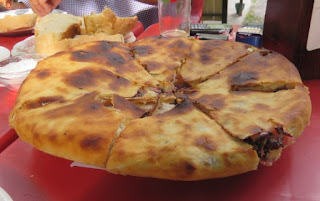 |
| Dill and red leafy vegetable filled Khachapuri |
 |
| Georgian dumpling - Kinkhali |
 |
| Bread with kidney bean filling - Lobiani |
 |
| Red Kidney bean stew - Lobio |
 |
| Brinjal with walnut paste - Nigvziani Badrijani |
A Svan breakfast spread - Corn bread, brinjal with walnut paste, cheese, cherry preserve, fresh bread, pastries, svanetian salt(salt with spices), fresh tomatoes, beetroot and cabbage salad
Georgian Language
Georgian is a very ancient language with rich literary tradition and is not closely related to any other language. What is interesting about the language is how 2 or more consonants of similar type are pronounced together and the challenge for any non-Georgian is that the words are pronounced exactly as written. Have a closer look at some of the Georgian words to understand what I mean and have fun pronouncing those words.
In any case, Gamarjoba for hello and Madloba for Thank you are without successively occurring consonants and can be used throughout the country without any troubles of pronunciation.
The point where conclusion is more welcome than more content:
I have tried to incorporate everything of import, many of my thoughts and experience of having spent 10 days in this beautiful country of wonderful and welcoming people. I had more of my thoughts to add but the length of the post started to make me uneasy and given my resolve to keep everything connected to a topic together, I made an effort to keep the content concise because of which this post reads more like a 'Guide to travelling in Georgia' than a travelogue that it's meant to be.
I look forward to going back to the country to explore the areas on the eastern side - the wine producing region of Kakheti, and the highlands of Tusheti and Khevsureti and in the meanwhile I dream about fresh and moist Churchkhela wherever hunger strikes between meals and I attempt to replicate lobio in my kitchen.




